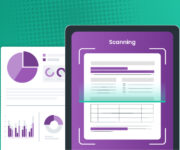The banking industry has constantly evolved, and technology has played a significant role in its transformation. The fintech or financial technology market is forecast to reach USD 699.50 billion by 2030, representing a 20.5% CAGR.
One key area where technology has significantly impacted is bank statement analysis.
Financial companies, banks and NBFCs thoroughly evaluate customers’ financial history during credit assessments. Bank statement analysis is a tech-enabled approach that simplifies this process, adding agility and accuracy. Therefore, many organisations increasingly adopt bank statement analysis software to shorten processing times, enhance efficiency, and streamline document processing.
This article discusses how technology can improve financial decision-making by analysing bank statement data.
What Is Bank Statement Analysis?
Bank statement analysis is the process of analysing the transactions on a bank statement to understand an individual’s or an organisation’s financial position.
The process involves importing the entire data of bank transactions into a software or tool. The analysis makes it easier to understand customers’ financial situations and identify areas for saving or improving.
The basic workflow of bank statement analysis
Bank statement analysis often involves categorising transactions into different types, such as income, expenses, and transfers.
It may also involve analysing transactions by categories, such as food, rent, utilities, transportation, entertainment, etc., to identify areas where you are overspending or can save money.
Importance of bank statement analysis
For businesses, bank statement analysis can provide insights into cash flow and financial performance, helping managers make informed decisions to improve profitability and growth.
In general, it is an essential tool for clearly understanding and improving your financial situation.
How Does Bank Statement Analysis Work?
The bank statement analysis process imports your bank account transactions into a software tool. Here is how it typically works:
-
Importing bank statements
The first step is to import your bank statements into the software or tool. This can typically be done by linking your bank account to the tool or manually uploading your bank statement file.
-
Categorising transactions
The next step is to categorise your transactions. This involves assigning each transaction to a specific category, such as food, rent, transportation, etc. The software may automatically categorise some transactions based on the information provided by the bank.
-
Analysing transactions
Once all your transactions are categorised, you can start analysing your spending habits. The software may provide tools and reports that help you understand your spending patterns, such as charts and graphs showing your spending by category or over time.
-
Identifying areas for improvement
Based on the data, you can identify areas where you may be overspending or could cut back. You may also recognise opportunities to save money, such as switching to a different bank or credit card that offers better rewards or lower fees.
Overall, it helps you better understand your financial situation and make more data-driven decisions about your spending and saving habits.
How Does a Bank Statement Analyser Improve Financial Decisions?
Financial experts can use a statement analyser to understand their company’s financial health better. Here are some ways a bank statement analyser can help:
Identify cash flow patterns
Cash flow is a critical factor in any business’s financial health, and a bank statement analyser can help identify patterns in a company’s cash flow.
By analysing bank statements, financial officers can determine when cash inflows and outflows occur, identify any irregularities, and identify the primary sources of cash inflow.
This information can help companies manage their cash flow more effectively, and improve liquidity.
Evaluate profitability
Bank statement analysis evaluates a company’s profitability by providing insights into its revenue and expenses.
Through analysing bank statements, financial professionals can identify trends in revenue and expenses, track changes over time, and identify areas where expenses can be reduced. This information can help companies increase profitability by making more informed financial decisions.
Detect fraudulent activities
Bank statement analysis detects fraudulent activities such as unauthorised transactions, checks, or forged signatures.
After identifying such commonplace irregularities in bank statements, financial professionals can investigate and take fast corrective measures to prevent exposure to such dangers, reducing the risk of financial losses.
Evaluating investment opportunities
Bank statement analysis can also help evaluate investment opportunities by providing insights into a company’s financial condition.
Consequently, financial experts can identify areas of strength and weakness, evaluate potential risks and returns, and make more informed investment decisions.
Consider These Factors Before Choosing a Bank Statement Analysis Software
When looking for bank statement analysis software, you should consider the following:
-
Automation
The software should have the ability to automate the process of importing and categorising transactions and generating reports. This helps save time and minimise errors.
-
Accuracy
The software should accurately categorise transactions and provide an accurate view of your financial data.
-
Flexibility
Look for software that allows you to customise categories, tags, and reports to fit your specific needs.
-
Security
Since bank statement analysis software deals with sensitive financial data, ensure the software provider has appropriate security measures.
-
Integration
If you use other financial software, look for bank statement analysis software that integrates with your existing tools.
-
User-friendliness
The software should be easy to use and understand, even for those without a finance or accounting background.
Summing Up
Bank statement analysis is essential for evaluating a company’s financial position. While the process can be challenging, technology has made it easier with the development of bank statement analysis software. The right software can simplify the process, making it more accurate, efficient, and user-friendly.
Soon, bank statement analysis will likely become even more critical for financial decision-making, making it essential for financial professionals to stay up-to-date with the latest technology and tools. Today fintech industry is redefining how bank statements are analysed using advanced technologies.
Finezza‘s Bank Statement Analysis tool Precisa provides highly accurate automated analysis of a client’s financial transactions. The software can detect fraudulent statements, circular transactions, irregular payments, transactions, and other discrepancies efficiently.
With just a few steps, you can integrate Precisa’s Analytics capability with your existing systems and give your team a smooth, fast and secure user experience.
Sign up here to learn more about how Finezza can optimise loan management with its bank statement analyser.




Leave a Reply